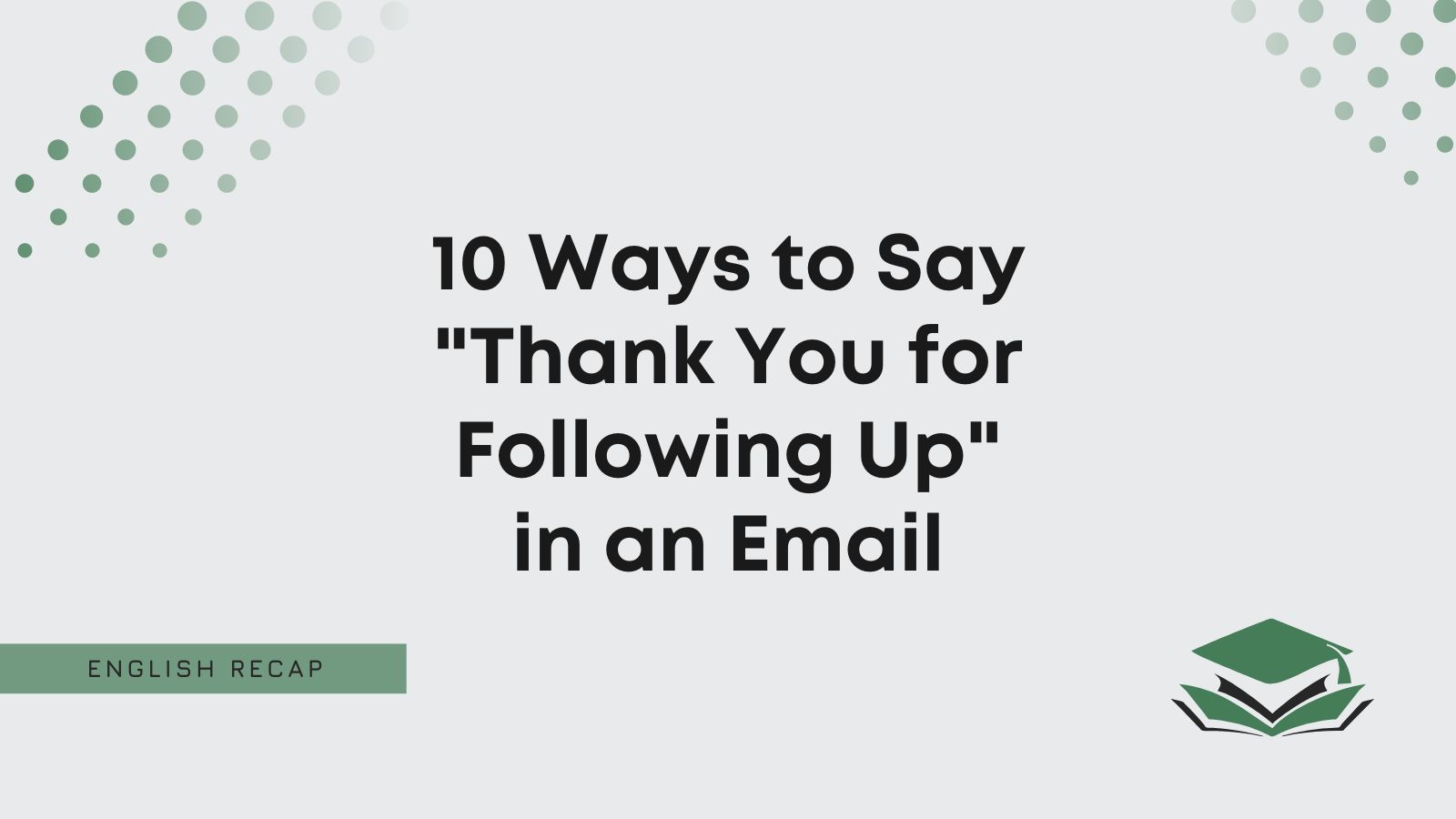So, you’ve just received a follow-up email and want to share your appreciation.
Perhaps you’re looking at using “thank you for following up.” But are you a little concerned it might sound a bit forced or repetitive?
Well, this article will explore how to say thank you for a follow-up email to help you understand your options.
Is It Professional to Say “Thank You for Following Up”?
It is professional to say “thank you for following up.” It’s a great phrase that shows you’re happy to receive a follow-up email from your peers.
Generally, it works best when you are expecting someone to get back to you.
If they waited a few days before replying to provide new information, this is a great phrase to use. It’s formal and polite, making it an excellent choice for business emails.
The email example will help you understand it better:
Dear Jazmine,
Thank you for following up with me regarding this. I’m so glad to hear that things are moving in a more positive direction.
Best regards,
Dan Winter
Pros
- It’s polite and respectful.
- It’s a simple way to share your appreciation for a follow-up message.
Cons
- It’s quite repetitive in emails.
- It’s a bit impersonal.
“Thank you for following up” is certainly a good phrase to use in business emails. It’s also not the only one! Therefore, we recommend having some alternatives ready to go.
Keep reading to learn how to say “thank you for following up.” That way, you’ll find some great alternatives to help you mix up your email writing.
What to Say Instead of “Thank You for Following Up”
- Thank you for checking back in
- I appreciate your follow-up
- Thanks for circling back
- I’m grateful for your follow-up
- Thank you for the update
- I’m thankful for your timely response
- Thanks for keeping me in the loop
- I’m glad you followed up on this
- Thank you for reaching out again
- Thanks for getting back to me
1. Thank You for Checking Back In
You can write “thank you for checking back in” after someone sends you an update in an email.
It’s a great way to show that you appreciate the follow-up email. Regardless of the information shared, this shows that you’re happy to hear it.
It’s formal and polite. It’s also quite a simple option. That’s why we like it when emailing a coworker. It shows you appreciate them without sounding overly professional.
Also, this email example should help you understand it better:
Dear Michael,
Thank you for checking back in on this matter. I have found a good way for us to move to the next stage.
Best regards,
Joe Adams
2. I Appreciate Your Follow-Up
If you want to know how to thank someone for following up, you can’t go wrong with “I appreciate your follow-up.”
It’s formal and respectful. Therefore, it’s good to use when emailing a recruiter.
It might work well after sending in a job application. It generally shows that you’re happy to hear from the recipient and would like to receive more updates.
We also recommend reviewing this email example:
Dear Mr. Ape,
I appreciate your follow-up email. It’s good to see that you’re keeping on top of this situation for me.
All the best,
Brian May
3. Thanks for Circling Back
To keep things slightly more informal, try “thanks for circling back.”
Now, don’t get us wrong; it’s still effective in professional emails. However, “thanks for circling back” is better when you’re friendly with the recipient.
Use it when contacting a supervisor. It shows you’re more than happy to hear from them, especially if their email relates to important or useful information.
Check out this example to see how it works if you’re still unsure:
Dear Taylor,
Thanks for circling back with me. I’ve been waiting to find out what your thoughts were on this project.
Best wishes,
Ben Thomas
4. I’m Grateful for Your Follow-Up
You may want to use “I’m grateful for your follow-up” after an interview. It’s a great way to show that you’re happy to hear more about the status of your job application.
It’s another way to say “thank you for following up” that keeps things more polite and genuine.
Therefore, it tends to work best when you’re happy to hear from a professional recipient. Someone like a potential employer or recruiter would work well here.
This example should also help you to understand it better:
Dear Mr. Gardener,
I’m grateful for your follow-up on my application. I appreciate that you took the time to update me here.
All the best,
Sue Jenkins
5. Thank You for the Update
Going back to the basics can help a lot when writing formal emails. Try “thank you for the update.”
Honestly, it doesn’t get more basic than that.
It’s a great phrase to include to help you sound professional and respectful.
Use it when emailing an employer after an interview. It shows you’re truly happy to hear from them and want to give them a good impression via email.
Check out this email sample if you’re still stumped:
Dear Miss Brighton,
Thank you for the update. I wasn’t expecting you to get back to me so quickly, so I appreciate your email.
Yours,
Frank Calvin
6. I’m Thankful for Your Timely Response
Feel free to use “I’m thankful for your timely response” if you’re impressed with the speed with which someone replies.
It’s a friendly synonym that shows you’re happy to hear back so quickly.
Generally, this will work better when emailing your boss. It shows you reached out previously and are happy to hear from them with a follow-up email providing new information.
Here’s a great email example to show you how to use it:
Dear James,
I’m thankful for your timely response. Thanks so much for letting me know that we can move forward with this.
Regards,
Bob Blakemore
7. Thanks for Keeping Me in the Loop
Next, you can try “thanks for keeping me in the loop” instead of “thank you for following up.”
This is a great, friendly, yet formal alternative that shows you’re happy someone stayed with you or provided you with an update.
We recommend using it when emailing your boss. It shows you genuinely appreciate hearing from them and are glad they’ve kept you up to date with something.
Feel free to review this email example as well:
Dear Miss Andrews,
Thanks for keeping me in the loop regarding this matter. It’s important that we stay up to date with these ideas.
Kindly,
Melissa Tate
8. I’m Glad You Followed Up on This
Another great phrase to include is “I’m glad you followed up on this.” It’s highly effective in professional cases when someone has reached out to you.
You should use it when thanking a customer for following up. It shows that they’ve been helpful and that you’re happy to receive their email.
Generally, this is a great way to build a solid working foundation with new customers. It shows that your company values its customers, which should encourage them to come back.
Also, this email example will help you to work it out:
Dear Mrs. Smart,
I’m glad you followed up on this. I appreciate your message, and I’ll be sure to keep on top of these things moving forward.
Yours,
Jon Wells
9. Thank You for Reaching Out Again
We also think that “thank you for reaching out again” is a great phrase to include in formal emails.
This time, we think it’s best to use it when emailing a team member. It shows that you’re happy to hear from them, especially if they’re reaching out about something important.
It’s polite and respectful, making it an excellent choice to use when emailing people you enjoy talking to. We highly recommend it to build a solid working foundation with recipients.
If you’re still unsure, review this example:
Dear Andre,
Thank you for reaching out again. This update is much more positive than the last, so it looks like it’s moving in the right direction.
Regards,
Tammy Whitworth
10. Thanks for Getting Back to Me
You can use “thanks for getting back to me” instead of “thank you for following up.”
It’s a more friendly way to show that you appreciate someone for providing you with an update.
We recommend using it when emailing a customer. If they asked you a question, but you needed further information, this is a great way to show that you’re happy to hear from them.
It keeps things polite and conversational while also giving off a more formal air. Therefore, it’s great to use in most customer service settings.
Here’s a great sample email to show you how it works:
Dear Mr. Scott,
Thanks for getting back to me. I’m glad you could update me on this. Now, I’ll be happy to work through your original query.
All the best,
Bailey Rayl

